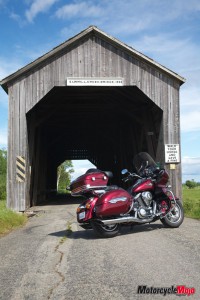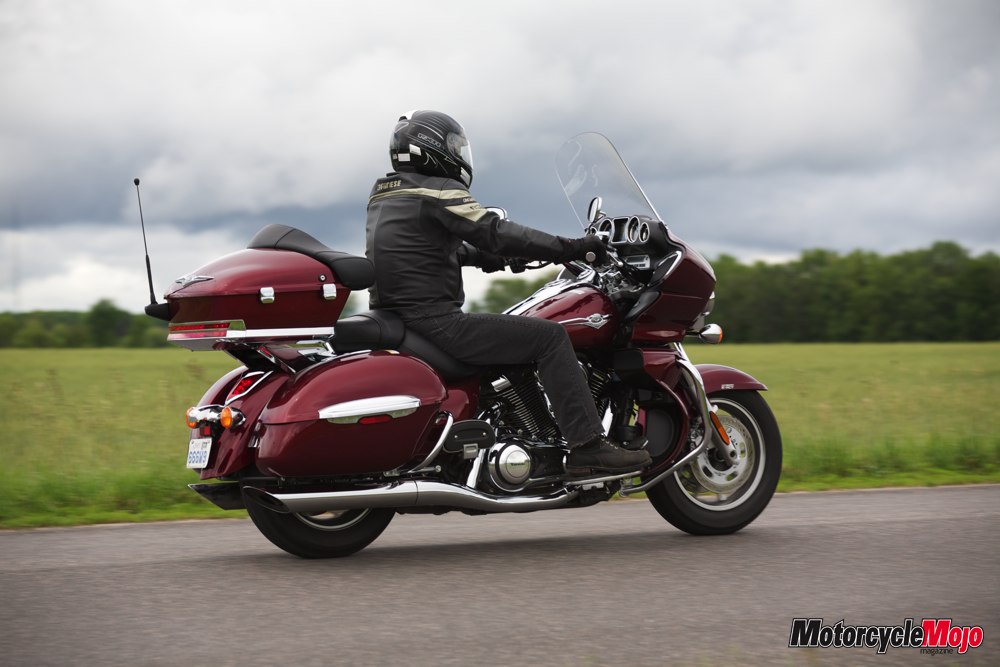Touted by Kawasaki as the first Japanese full dress V-Twin tourer, the all new Voyager 1700 marks Kawasaki’s re-entry into the full touring segment. It is also the flagship of their newly released line of four cruiser-based models with the new power train and chassis.
The Voyager benefits from a host of improvements ushered in with the new 1700 platform vs the 1600 it replaces. The new long stroke liquid-cooled, single overhead cam, 8-valve 1,700 V-Twin generates approximately 15% greater torque (claimed 107.7 ft lbs at 2750rpm) than its predecessor. Taking advantage of this new muscle, an extra gear has been added endowing the big Kawi with a 6-speed box. Complementing the new motor, the all- new double cradle steel frame boasts lighter weight and a 40% increase in torsional strength over its forerunner with the promise of improved handling.
Replacing the shaft drive system of the 1600, the new 1700 platform relies on an all new belt that is carbon fibre rather than Kevlar based for a claimed 40% increase in tensile strength. This enabled the engineers to use a relatively narrow belt of 28 mm while maintaining high levels of reliability.
The styling of the new Voyager leaves little doubt as to its main influence and very sparing use of brand badging helps to cloud people’s impression leaving many to ask if this was a product of a certain American manufacturer. However Kawasaki alludes to styling ques taken from American sports cars of 60’s vintage and ended up with an attractive, flowing design that is pleasing to the eye.
Storage capacity boasts 126-litres of locking cargo space including 50-litre trunk (with room for two full face helmets) and top opening panniers of 38-litres each. Two lockable glove boxes offer useful space for storing frequently needed items such as wallet or camera.
Fit and finish of my test bike was of high standard including the rich ‘Candy Diamond Red’ paint with tasteful applications of chrome accent. Unfortunately, some of that paint took on a somewhat hazy patina where my rain pants came in contact with the rear of the tank. I hoped a quick buff of the clear coat would take care of that.
 While its styling might be inspired by shapes of decades past, the Voyager is host to some of the latest technology incorporated on road-going motorcycles. The new K-ACT (for Kawasaki Advanced Coactive-braking Technology) ABS system utilizes the computer ECU to detect brake force applied by the rider and then determines the optimum brake force for maximum efficiency. This is not a ‘linked’ system, rather K-ACT applies force through motor operated fluid pumps to the dual 300 mm 4-piston front and 300 mm twin-piston rear brakes as required.
While its styling might be inspired by shapes of decades past, the Voyager is host to some of the latest technology incorporated on road-going motorcycles. The new K-ACT (for Kawasaki Advanced Coactive-braking Technology) ABS system utilizes the computer ECU to detect brake force applied by the rider and then determines the optimum brake force for maximum efficiency. This is not a ‘linked’ system, rather K-ACT applies force through motor operated fluid pumps to the dual 300 mm 4-piston front and 300 mm twin-piston rear brakes as required.
Experimenting with the ABS system in both wet and dry conditions, I found braking to be strong with good feel. There was very little kick back or pulsing in the handle or foot levers when ABS was activated which might otherwise be a distraction in an emergency situation.
Passing a country road that had just been finished with chip and tar, I couldn’t resist seeing what K-ACT ABS would make of it. Riding at a good clip in the middle of the lane where a line of stone had piled up, and against my better judgement, I tromped the pedal and grabbed the lever hard and just held on. The bikes brain wasn’t fussed, and testing the traction limit of the Bridgestone Excedras with short audible skids, brought the big rig to a smooth stop in a far shorter distance than I ever would have expected. Very impressive indeed.
Making further use of the ECU brain, Kawasaki has employed their first fully electronic throttle actuation system (or ‘fly by wire’) for precise fuel and air delivery. Throttle feel is quite natural, but the computer does the rest of the figuring to ensure the correct charge of fuel and air gets to the cylinders regardless of speed or condition.
Pulling away with even a cold engine is smooth and hiccup free, but unfortunately, Kawasaki recommends a 12-second wait upon start up before twisting the throttle. This situation arises from the system’s need to recalibrate settings with each start. I very rarely heeded the recommendation and occasionally found the idle speed to fluctuate mildly as the computer had selected a set value to run with instead of optimal settings.
 Cockpit amenities are complete with full range of instrumentation including needle type tach, speedo, temperature and fuel gauge. A large, well positioned LCD display provides information on fuel consumption and remaining range plus gear position, odometer, clock and dual trip meter. One complaint I had of the cockpit layout would be the positioning of the horn button which requires a bit of a reach and once activated, the sound level of the horn is limp. Please give me a horn that will discipline road hogs and texting fools.
Cockpit amenities are complete with full range of instrumentation including needle type tach, speedo, temperature and fuel gauge. A large, well positioned LCD display provides information on fuel consumption and remaining range plus gear position, odometer, clock and dual trip meter. One complaint I had of the cockpit layout would be the positioning of the horn button which requires a bit of a reach and once activated, the sound level of the horn is limp. Please give me a horn that will discipline road hogs and texting fools.
Standard on the Voyager is a 40-watt, two speaker am/fm stereo with styling, as Kawasaki again claims, harks back to the ‘60s and takes the look of an 8-track player. Better that than a reel-to-reel tape deck I suppose, but breaking free from ancient times, optional components allow the stereo to interface with iPod, XM tuner and CB radio.
The opportunity for a proper test of the Voyager’s capabilities presented itself in the form of a 3,200 km round trip ride to the Motorcycle Mojo sponsored Atlanticade event in Moncton, New Brunswick early this summer.
Climbing aboard the Voyager, I found the 406 kg (895 lb) weight (claimed dry) to be a hefty but reasonable lift off the side stand. Pushing backwards on anything but level surfaces took some effort, although the low 730 mm (28.7 inch) seat height helped to keep it manageable. Once in motion, the low center of gravity and comfortable ergonomics paid off with easy to manoeuvre handling. Even at parking lot speed, the big Kawasaki seemed to shed weight allowing for surprisingly tight turns.
Though designed to be a stable and well-equipped platform for one or two- up highway travel, twisting back roads need not be avoided with the Voyager as the rider will enjoy surprisingly light, weave—free handling. Predictably though, as with most other cruisers the low mounted floorboards limit lean angle. For the type though, the Voyager leans well before the audible warning of scraping metal on pavement prompts the rider to mind their manners. As the boards are hinged, a few more degrees of additional cornering angle offer a margin of safety before more dangerous grindings occur.
Settling in for the long haul, I started to get more acquainted with my mount for the next six days and almost immediately found myself smack dab in the middle of foul stop and go (heavy on the stop) Toronto traffic. The cooling system proved it was up to the task with the needle staying away from the red zone, and with little of the heat directed at the rider, comfort was good. Light clutching was complemented with a wide engagement and shifting was precise, but shifts from first to second were accompanied with a substantial mechanical clunk that wasn’t as audible with any other cog changes.
Finally on the open road and into gusty truck wake, the Voyagers stability proved to be excellent as the new frame with solidly mounted fairing shrugged off most of the turbulence with only light twitches passing through the bars and seat.
Riding with a friend whose sidecar-encumbered bike was limited to 160 kilometers for fuel stops meant plenty of stops along the way. Under these conditions, seat time wasn’t fatiguing and we finished off the first day with 900 kilometers covered. The Voyager’s averaged 7.2 L/100 km (39 mpg), leaving a potential distance till empty in the 277 km range. While allowing a comfortable ride over the long haul, sipping fuel certainly isn’t the Voyager’s forte and will require a couple extra fuel stops on a long trip.
The riding position places the rider in position of comfort and control, but I would have appreciated the addition of highway pegs for a bit of a stretch. Seating was likewise good with a wide and well padded perch.
Suspension duties are handled by a stout 45 mm fork up front and twin rebound adjustable air-assisted shocks out back. Considering the Voyager’s smart handling on curvy roads, the plush ride on the highway was a nice surprise. One memorable bump on Highway 20 in Quebec had my travel companions griping. In fact, the passenger on one bike became airborne and wasn’t sure she would land back on the seat. In this case the Kawasaki’s compliant suspension with 140 mm (5.5 in) fore and 80 mm (3.1 in) travel aft, swallowed most of the jolt and passed minimal shock to the rider.
Thrust from the all new 1700 cc V-Twin is robust. Acceleration is strong right up to the 6000 rpm red line with lots of associated bluster, but the torque curve is so wide down low that there is little need to wring its neck. Even sixth gear found the Voyager willing to pull smartly without hesitation or stumble. That is of course if the mandated premium fuel is used. One load of foul crap from a station in New Brunswick had the motor knocking noticeably while accelerating from low rpm. Yuck! Not the bikes fault, but I would carry a small bottle of octane boost for just such circumstances.
Outside of the main centres the roads were lightly travelled, and steady cruising at an indicated 120 km/h found the tach at 2800 rpm. At this speed, the power pulses while softened by chain-driven balance shafts and crankshaft mounted cam damper, still provided a satisfying feeling of character. The chuffing (just loud enough) baritone exhaust note complemented the effect nicely providing an enjoyable sense of relaxed travel.
The return trip found us in Quebec with England’s weather, where we encountered every type of rain imaginable from misting to hard-driving. The large fairing, windscreen and leg guards (ventable for airflow in good weather) fended off the lighter stuff well at speed, but after awhile with the rain picking up in strength, the pocket of air became simply a damp space.
With a total of 5,000 km under my belt in all kinds of weather and all types of road, I found Kawasaki’s re-entry to the niche is anything but rushed or half-hearted. The Voyager’s offered level of features and competence at only $21,699 show that this worthy competitor in the full-dress touring segment should find many a home in Canadian driveways.
Go to www.kawasaki.ca for more information or to find a dealer near you.




















































